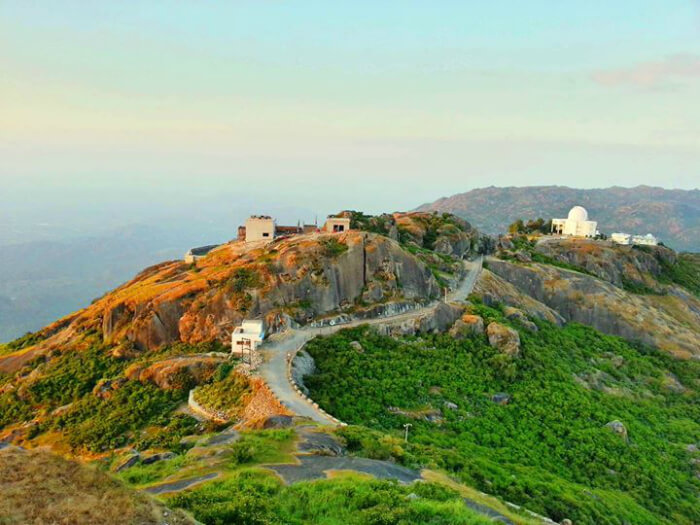Hummingbird Blog
Historical Facts Reviled about Mount Abu Rajasthan

Mount Abu has incredibly known among vacationers for various myths and facts that describes perfectly by a group of saints, and the story begins like this.
The Ancient Saga
In the past, Mount Abu was a part of "Arbudaanchal" and was the shelter for many religious people. According to legend's idiom, all the 330 million Hindu Gods and Goddess have gone by the Abu Mountain that was scared in ancient time. The mountain was a thickly forested territory with sage Vashishth dwelling the place. It trusted that Saint Vashishth played out a consecrated "Yagna" to make four Rajput groups of flame named as Agnikula. This Yagna occurred next to a natural spring, which left a stone with the state of cow's head.
Numerous myths intertwined with the introduction of this place. One conviction is that Vashishth's pet bovine Nandini once caught up in a deep chasm and helped by Lord Shiva, who sent Goddess Saraswati through the canyon. Goddess Saraswati streamed like a waterway and helped Nandini to skim up and discover her way to wellbeing. To keep away from such an inconvenience in future, Vashishth solicited the most youthful child from Mighty Himalaya to top off the abyss. It trusted that the Lord shut the ravine with the assistance of forceful snake, Arbud. Over time, this place known as Mount Arbud, which later on renamed as Mount Abu.
With the introduction of the four Agnikula Rajput factions, the mountain got extraordinarily precarious and prompted rough visit tremors. Lord Shiva helped the place by putting his enormous toe on the consecrated Achalgarh. That is how the pinnacle of Mount Abu came known as "Guru Shikhar" with Sage Vashishth's ashram known, as Gaumukh is a well-known place for the fans to pay the visit.
There are legends identified with this legitimate mountain. One of the myths recounts an exceptionally old yet intense sadhu named Balam Rashiya, who was interested in marrying a beautiful girl of this area. Her parents, however, were against this marriage and requested that the sadhu uncover a lake with his fingernails before the following day sunrise. They imitated a chicken and prepared during the dawn time. In this entire procedure, Lake Nakki formed.
Ancient Emperor of Mount Abu
Any ruler outside the district had not governed Mount Abu, and this is because of the troublesome landscape with thick timberland, which made successes unimaginable. There is a shortage of real chronicled data about Mount Abu. Neighborhood individuals are more adherents of the different myths of the area. The soonest known faction of the locale is the Nagas and the Bhillas. The primary ever ruler was the Dhumraja in 916AD, who otherwise called Parmer, which means the adversary slayer. At that point the Solankis, who are the ace modelers. Their design widely acclaimed, a case of which is the well-known old Delwara Temple of Gujarat.
The Solankis were wild warriors and conquered the entire Rajasthan. With time, King Bimal Shah was loaded with regret and constructed the structurally opulent Delwara Temple, to improve his life from his willful sin. Tejpal and Vastupal, the best engineers of the time helped the ruler to fabricate the new sanctuary. The Parmers were all the while dwelling in the area with wonderfulness given by the Solankis. Rao Lumba of Deora-Chauhan line washed all their wonderfulness away in 1311. They kept on the decision for over a century and moved the capital a few times from Chandravati to Sirohi. Rao Shashmal of the Deora tradition kept on the decision the locale until 1405.
Mount Abu and a noteworthy bit of Rajasthan and Gujarat accepted to be at the encapsulation of greatness under the government of the Gurjars. The entire locale is famous as the "Gurjarabhumi" for quite a long time before the Mughal run the show.
Mughal and British Rule
At the time of Akbar's era, Mount Abu alongside the whole Rajasthan went under the Mughal realm. Amid Mughal time, Mount Abu lost its significance and remained a little sloping locale. It was with the fall of Mughal time and ascent of the British Empire that the area developed its relevance. The province of Rajasthan was under the Rajputana control, which aligned with the British and controlled calmly. Colonel Todd rediscovered the hill station and made Mount Abu the late spring capital of the Rajputana state. With time, Mount Abu picked up significance among the Rajput rulers, who influenced beautiful royal residences and "Vakalat To house" in the district.
The British with time had made numerous religious community schools and paramilitary cantonment in the district. One street interfacing Mount Abu with the fields was the Abu Road (otherwise called Kharadi), which picked up significantly after the Second World War. Now time, when the British administer, was very nearly consummation and India was going to pick up its flexibility. The Indian Constitution shaped in 1947, with the tourism industry picking up significance crosswise over India. Mount Abu turned into a favorite visitor spot, inviting individuals crosswise over India to appreciate the astonishing cold climate in the midst of the warmth of Rajasthan.















